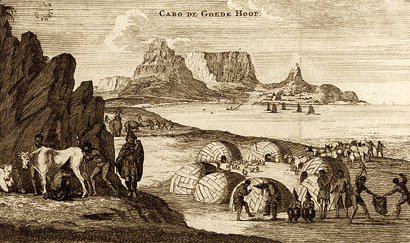 Smallpox at the Cape, introduced from the Orient, first made its appearance as an epidemic on Friday 13th 1713 when a crew member aboard a ship was infected with the disease. His clothes were taken out to be washed in the river near the castle which in turn contaminated the local drinking water. Another outbreak occurred later in 1755 and hit the Cape Settlement very hard. It ravaged all the Hottentot tribes, this together with the pressure of the fast expanding settlement, largely destroyed the tribal life of the Hottentots of the 18th Century. Many tribes were wiped out. Their numbers were reduced so much that their tribal organisation disintegrated and they were gradually taken into service as labourers, especially herdsmen by the local farmers.
Smallpox at the Cape, introduced from the Orient, first made its appearance as an epidemic on Friday 13th 1713 when a crew member aboard a ship was infected with the disease. His clothes were taken out to be washed in the river near the castle which in turn contaminated the local drinking water. Another outbreak occurred later in 1755 and hit the Cape Settlement very hard. It ravaged all the Hottentot tribes, this together with the pressure of the fast expanding settlement, largely destroyed the tribal life of the Hottentots of the 18th Century. Many tribes were wiped out. Their numbers were reduced so much that their tribal organisation disintegrated and they were gradually taken into service as labourers, especially herdsmen by the local farmers.
The epidemic spread far into the interior and many Europeans fell victim to the surge as well. A quarter of white inhabitants died in the first epidemic and nearly half the Cape Slaves also died. This disease was also rife in Europe and the East. By May 1713 the smallpox diseases had researched epidemic proportions. The dead could not be buried in coffins as there were was a shortage of wood at the Cape.
Many of the survivors fled to the interior. Those who remained behind took service with the whites or went to live at the Mission Stations.
Small pox was also found to a lesser extent in the Bantu Tribes and was attributable not only to their primitive living conditions living in rural areas of the country, but also to the fact that the disease commonly occurs in a mild form known as “amaas”.
Further outbreaks of the diseases broke out in 1767, 1807, 1812, 1839, 1858 and 1881. Not long after the 1881 epidemic, the Jennerian (calf lymph) vaccination was already clearly recognised as the most effective prophylactic measure, but had not been adopted to any extent in South Africa. The Malay Population at the Cape, who on religious grounds had consistently refused the vaccinations and suffered particularly severely. But in other races, largely also unvaccinated, there was also heavy mortality, and the disease spread far inland.
Did you know that ?
 The Bubonic Plague was introduced into South Africa during the 2nd Anglo Boer War from rat infested fodder imported by the British Military authorities from ports in South America and India where the plague was raging at the time.
The Bubonic Plague was introduced into South Africa during the 2nd Anglo Boer War from rat infested fodder imported by the British Military authorities from ports in South America and India where the plague was raging at the time.
The lesson learned, and the first compulsory vaccination law was enacted by the Cape Parliament. Vaccinations continues to be resisted by certain sections (and sects) of the population, with the result that not since 1881 has the country been entirely free of the infection.
Well known people who have died in the epidemic were De Meillon, Dominicus Blesius and Lambert son of Hottentot Chief Ambraal.
Source: Theals History of the Cape, Standard Encyclopaedia of South Africa and Readers Digest Illustrated History of South Africa.





